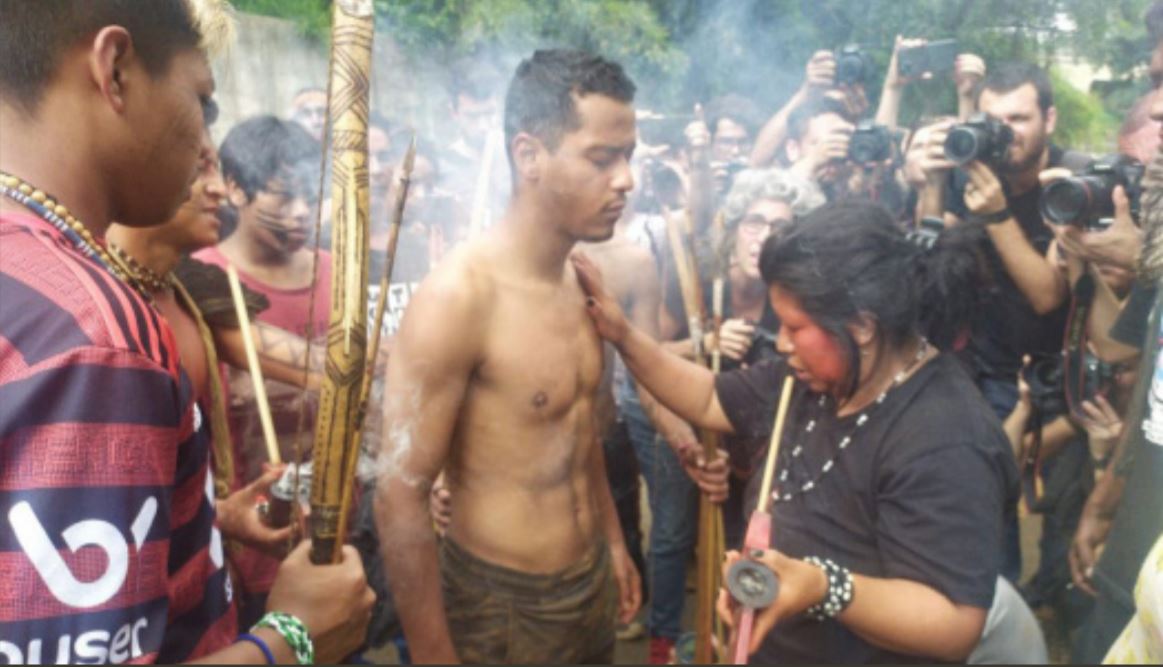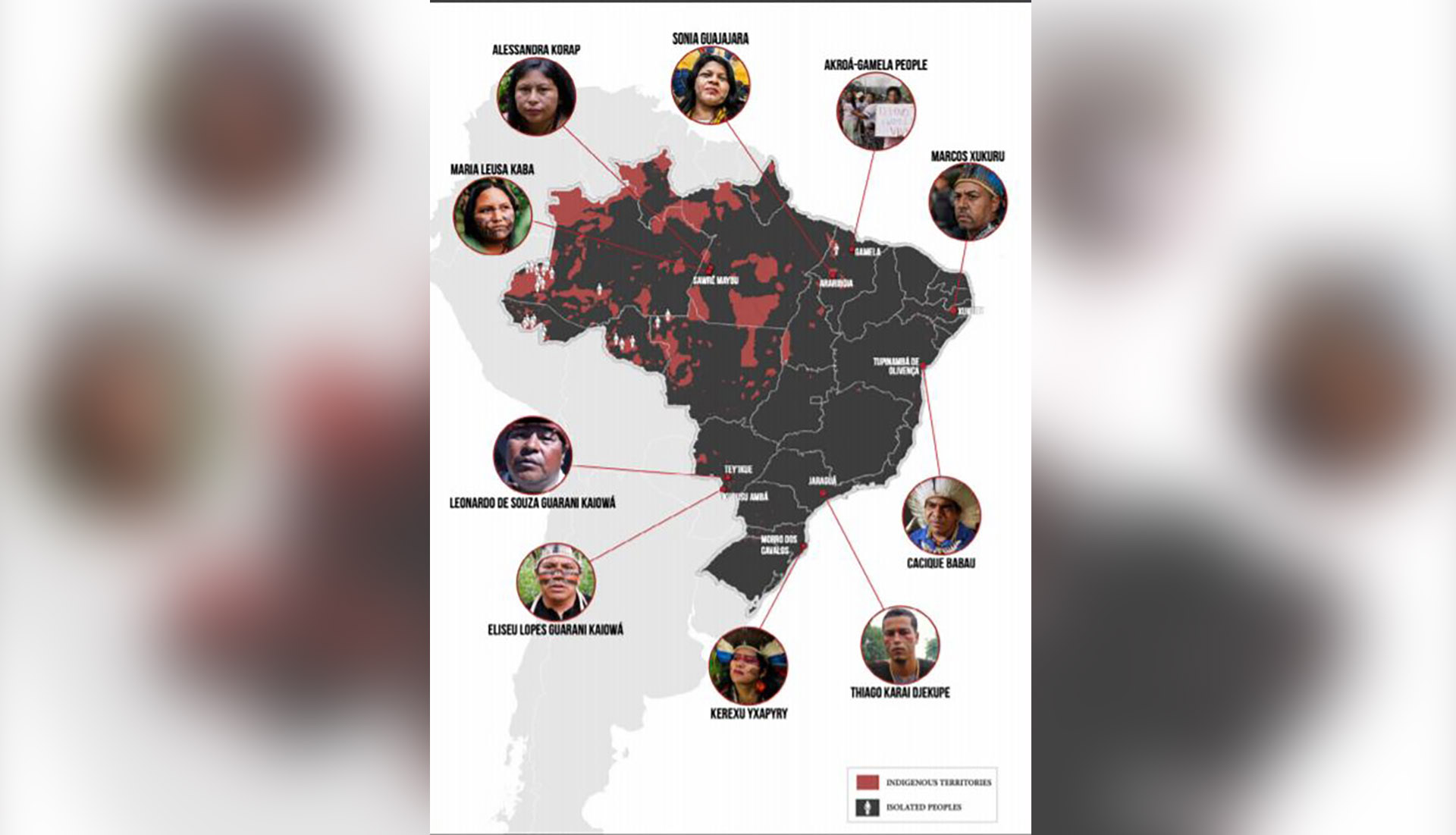The threat from a hostile Federal Government worsened with the COVID-19 pandemic where lack of access to proper health care, especially in remote areas in the Amazon, coupled with the absence of immunological memory for infectious agents of Indigenous Peoples make them particularly vulnerable to the virus.1 From April 2020 to January 2021, around 941 Indigenous Peoples in the Amazon were reported to have died from the virus, half of them within Brazil.2 Brazil’s President, Jair Bolsonaro, has been consistent in being callous towards the plight of Indigenous Peoples during the pandemic and even took advantage of it to open their lands for illegal exploitation.
In 2020, there were 1,083 incidents of violence involving land occupation and possession with 178 cases of invasion of indigenous territories and 18 murder victims, of which ten were Indigenous.3
Sônia Guajajara, coordinator of the Articulation of Indigenous Peoples of Brazil / Articulação dos Povos Indígenas do Brasil (APIB) said,
“This is amoment of general alert, because we’re completely cornered by the virus on one side and the genocidal measures of this fascist government on the other.”4
The 1988 Constitution was crucial in easing militarization in indigenous territories and recognizing Indigenous Peoples’ collective rights. The Bolsonaro government, however, is quickly eroding the staggered progress of realization of these rights. He has kept the promise he made when he took office in January 2019 when he said, “There will be no demarcation of Indigenous Lands under my government.”5
In February 2020, Bolsonaro introduced a Bill opening indigenous lands to mining. Although the Bill did not prosper within that year, he pushed Congress to prioritize the passing of the bill in January 2021.6 He refers to the Bill as the ‘dream,’ while indigenous leaders call it a “genocide Bill.”
In April 2020, the National Foundation for the Indians / Fundação Nacional do Índio (FUNAI), a government body that establishes and carries out policies relating to Indigenous Peoples, issued a directive opening 38,000 square miles of indigenous lands to outsiders.7 It means that “invaders of indigenous land can (now) ask for this certificate from FUNAI and, brandishing this document, can then request from INCRA (federal government’s land agency) the legalization of the areas they have invaded, using the Institute’s (newly revised) system by which they, the landowners (themselves), determine the boundaries of their land.”8
Indigenous leaders in Brazil have been rallying against Bolsonaro’s plans of “genocide, ethnocide and ecocide.”9 Discrimination and social exclusion of Indigenous Peoples have always existed in Brazil. These have recently turned to outright hatred, even from the media and from private citizens, and further inflamed by the federal government.
“This is a moment of general alert, because we’re completely cornered by the virus on one side and the genocidal measures of this fascist government on the other.” - Sônia Guajajara, coordinator of the Articulation of Indigenous Peoples of Brazil / Articulação dos Povos Indígenas do Brasil
IPRI’s and APIB’s report, Uma anatomia das práticas de silenciamento indígena: Relatorio sobre criminalizaçao e assédio de lideranças indígenas no Brasil, presented the experiences of 12 indigenous leaders from 11 indigenous territories in Brazil. Many of these indigenous leaders have lost family and community members from the decades-long fight to defend their lands, territories and natural resources. Those who were killed, often executed with impunity, had received threats prior to their demise. The same threats are currently being endured by these indigenous leaders as they continue defending their lands, territories, and traditional healing practices. They and their families often become vulnerable to attacks and harassments after attending public demonstrations or if they openly express their opposition to encroachers and aggressive development projects in their territories. Aside from physical threats, social media have become a common platform for harassment. Two of the 12 leaders received threats through WhatsApp and one of them vilified through Twitter. Their presence in media and social media makes them targets of more attacks and harassments.

AGGRESSIVE DEVELOPMENT CLOSING IN ON THE GUARANI MBYA PEOPLE FORCING THEM TO LEAVE THEIR TERRITORY
On January 10, 2020, Indigenous Guarani Mbya peoples began their 40-day demonstration, locally known as Ocupação Yary Ty, against the real estate developer Tenda Negócios Imobiliários. Tenda plans to build an 8,624 sqm condominium near the demarcated Jaraguá Indigenous Territory, which is located within the Jaraguá Tourist Park in São Paulo, Brazil. It is the smallest indigenous land in the country with an area of 1.7 hectares and was officially granted approval as Indigenous Land in 1987, ahead of the 1988 Constitution.
In 2019, accompanied by officers from the São Paulo City Government, Tenda approached the indigenous community to inform them about the cutting of trees next to their territory, claiming they had been authorized by the government body, FUNAI. The community was aware that an environmental impact study needed to be conducted, and that a simple verbal agreement with Tenda was not the way to proceed.10
The City Government and Tenda ignored federal policies and proceeded with the tree cutting. On January 30, 2020, Tenda felled more than 500 trees, including several cedars that are considered the most sacred trees in Guarani Mbya culture.11 Cutting these required the Guarani Mbya peoples to perform a ritual, ask for forgiveness from the trees, and observe a funeral ceremony in honor of the fallen trees.
Thiago Karai Djekupe, a 26-year-old Jaraguá leader, led the mobilization of his community after the trees were cut. He led the hours-long negotiation with a swarm of police – about 155 officers, a drone, and 15 support patrols – deployed to carry out a repossession order on behalf of Tenda.
Before complying with the agreement reached in the negotiation, which is to move the Ocupação Yary Ty to the entrance of the land, Karai Djekupe declared:
“São Paulo City Hall is waiting for us to confront the police. They are expecting us to spill our blood, or that we spill the blood of juruás (non-Indigenous). But we are not violent people. The conflict that Tenda was hoping to happen is in the interest of São Paulo Mayor Bruno Covas. We are guardians of the forest and we will continue to fight for it. We will resist in its name. We will not clash with the police. The Mayor has to be held accountable for this conflict that his office and Tenda themselves incited.”
Although the repossession warrant has been complied with, Tenda was prevented from moving ahead with the construction after the Federal Court blocked it following the intervention of the Federal Public Prosecutor’s Office. However, a document submitted to the Federal Court in São Paulo states that the decision of whether or not to continue with the development falls under state jurisdiction and not up to the Federal Court to analyze the case since there is no invasion of indigenous land.12 The Federal Prosecutor claimed that the Guarani Mbya are urban Indigenous Peoples living close to the railroads and gas stations, thus, there were no indigenous rights to consider, only environmental issues.
After the standoff with the police, Thiago Karai Djekupe had to be more careful in moving about. His exposure to the media made him vulnerable to harassment. He was already falsely illustrated in Tenda’s brochure with a stereotypical bow and arrow in a consultation as if to depict that Tenda has properly consulted the Guarani Mbya in Jaraguá Indigenous Territory.
The organization, Guarani Yvyrupa Commission, filed a motion to dismiss the case put forward by the Federal Prosecutor. The fate of the Ocupação Yary Ty remains uncertain, but Tenda seems confident they will have their way in the end as it continues to advertise its apartments at the base of Pico do Jaraguá, the highest mountain in the city of São Paulo.13
ISOLATED INDIGENOUS PEOPLES ARE ENDANGERED AS FUNAI OPENS THEIR TERRITORY TO LAND GRABBERS AND FUNDAMENTALIST MISSIONARIES
In November 2020, the Human Rights Observatory for Indigenous Peoples in Isolation and Recent Contact / Observatório dos Direitos Humanos dos Povos Indígenas Isolados e de Recente Contato (OPI) revealed that the government body, FUNAI, had plans of reducing the Ituna/Itatá indigenous territory to about 50 per cent, which is around 142,000 hectares.14 This will further encourage illegal miners, loggers and other land grabbers to encroach in indigenous territory. The lives of the isolated Indigenous Peoples will be at greater risk, especially at the time of a pandemic.
Indigenous Peoples in isolation and recent contact do not have immunological memory for infectious agents common among the Brazilian population, making them more vulnerable to illness and dying from common communicable diseases.15 The coming of outsiders not only poses a direct threat to their lands and territories but also to their physical survival.
FUNAI’s plans to open these territories for exploitation by outsiders started with Senator Zequinha Marinho (PSC-PA), an evangelical pastor and defender of miners in the state of Pará. As a member of the Bolsonaro government’s support base in Congress, he has been lobbying for the nullification of the ordinance restricting the exploitation of the Ituna/Itatá indigenous territory.
According to OPI, the current three major forms of persecution of isolated Indigenous Peoples in Brazil are through: i) grabbing of their lands; ii) grabbing of their souls, and iii) harassment linked to the exploitation of their territories and natural resources.
In March 2020, American evangelical pastor, Josiah McIntyre, threatened to burn the headquarters of the Union of Indigenous Peoples of the Vale do Javari (UNIVAJA) to obtain permission to enter the Vale do Javari indigenous territory, home to the majority of the isolated Indigenous Peoples. McIntyre is just one of several evangelists wanting to proselytize isolated Indigenous Peoples.16
In April 2020, through the Federal Public Prosecutor’s Office, UNIVAJA filed a public civil action before the Federal Court in Tabatinga, in the state of Amazonas, which presents the highest number of COVID-19 cases. They requested that missionaries be prohibited from entering indigenous lands and territories and for FUNAI to expel those already inside the area. The Federal Court provided the protection, but it still is not a foolproof guarantee of the safety and security of the isolated Indigenous Peoples.
Read and download the full IPRI's 2021 Annual Criminalization report here.


%2020.49.20.png)
